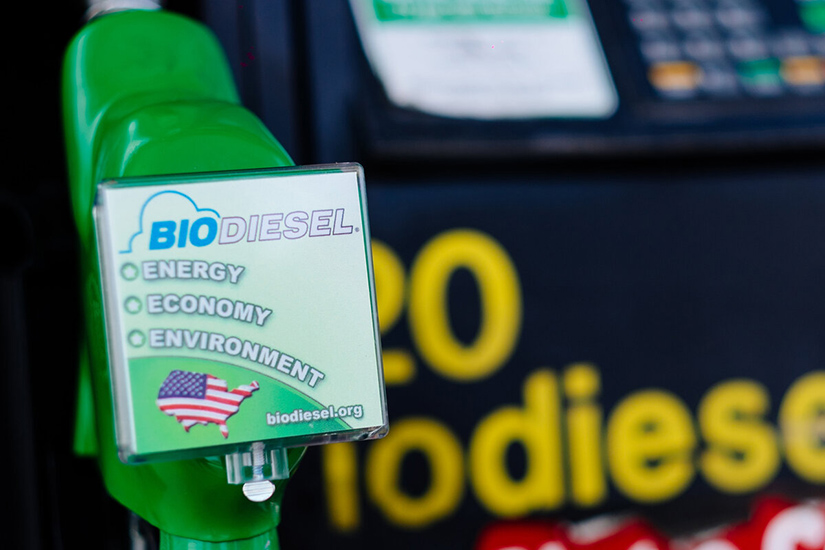NREL Research Points Path to Higher Blends of Biodiesel
September 20, 2024

NREL researchers have identified strategies to blend more biomass-based diesel fuel
into petroleum diesel. Photo from National Biodiesel Board, NREL
Barriers that are currently preventing the use of greater percentages of biomass-based
diesel fuel blended into petroleum diesel have been identified, along with strategies
to overcome them, according to researchers at the National Renewable Energy Laboratory
(NREL).
The bio-derived diesel fuel in use today is blended into petroleum diesel at a relatively
low percentage, typically from 5% to 20%. An NREL team investigated the performance
of much higher blends of biodiesel into both renewable diesel and petroleum diesel.
They specifically examined blends of 20%, 40%, 60%, and 80%. A switch to using higher
percentages of biomass-based diesel fuels would reduce the amount of greenhouse gasses
emitted by the transportation sector. Biodiesel is an oxygenate made from fats, oils,
and greases. Renewable diesel is made from the same feedstocks but processed to be
a hydrocarbon chemically similar to petroleum diesel.
“It’s amazing to me, but there are thousands of papers published every year on biodiesel,
and almost nobody looks at blends over 20%,” said NREL Senior Research Fellow Robert
McCormick, corresponding author of the newly published research paper “Properties That Potentially Limit High-Level Blends of Biomass-Based Diesel Fuel,” which appears in the journal Energy & Fuels. “This research addresses a major data gap about biodiesel blends, both because it
looks at high-level blends and because it looks at blends with renewable diesel as
well as petroleum diesel. Biodiesel blends with renewable diesel are 100% renewable.”
The paper was coauthored by researchers Gina Fioroni, Nimal Naser, and Jon Luecke,
all also from NREL.
The researchers examined biodiesel produced from soybean oil, which is the most common
feedstock used in the United States to make the fuel. They pointed out that a detailed
understanding about the properties of biodiesel blended at levels above 20% is lacking.
Heavy-duty long-haul trucks and off-road equipment, marine shipping, and commercial
aircraft are expected to continue requiring liquid fuels even as electrification of
smaller vehicles ramps up. These fuels will need to be low-net greenhouse gas emissions—such
as biodiesel and renewable diesel—and compatible with existing engines. The use of
biodiesel and renewable diesel is forecast to reduce transportation-related greenhouse
gas emissions from 40% to 86% compared to petroleum diesel, depending upon the feedstock
used.
McCormick said with a biodiesel blend greater than about 50%, “you start to have property
differences with petroleum that that could be problematic.” At less than 50%, the
differences do not pose much of a challenge.
Challenges with biodiesel blends greater than 50% can be mitigated, however. For example,
diesel fuels must be reformulated in winter months to ensure that the cloud point—the
temperature where wax begins to form—is below the expected ambient temperature. Wax
can cause fuel filter clogging such that the engine cannot operate. Biodiesel cloud
point can be as low as 20°F but for soy biodiesel is around 32°F, making the use of
100% biodiesel problematic in areas with colder winters.
“This issue can be managed by reducing the blend level or by blending the biodiesel
into different hydrocarbon blendstocks with a lower cloud point during the winter
months—as is commonly done today for B20 [a blend of 20% biodiesel and 80% petroleum diesel],” McCormick said. “A similar strategy could be used to mitigate the high boiling
point of biodiesel, which is near the top of the diesel boiling range.”
A hydrocarbon blendstock with a lower boiling point, such as kerosene, could be used
for biodiesel blends over 50%, alleviating challenges in cold starting the engine,
accumulation of fuel in the engine lubricant, and potentially failure of emission
control catalysts to “light-off” or achieve high enough temperature.
The research, which was funded by the U.S. Department of Energy’s Vehicle Technologies
Office, also examined other fuel properties such as density, oxidation stability,
and water content to determine whether these might limit the blending of biodiesel.
Oxidation stability, for example, may be reduced as more biodiesel is blended, but
the problem can be overcome by using higher levels of antioxidant additives.
Significant future research is needed to address the challenges of high level biodiesel
blends, particularly on how they impact diesel engine emission control systems. The
NREL paper serves as a research road map for addressing these challenges.
Learn more about NREL’s sustainable transportation and mobility research. Sign up for NREL’s quarterly transportation and mobility research newsletter, Sustainable Mobility Matters, to stay current on the latest news.
Search
RECENT PRESS RELEASES
Related Post





